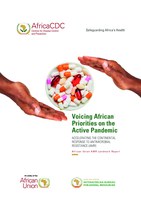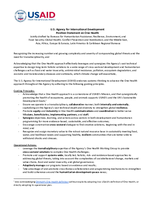One Health Evidence and Guidance
Unfulfilled Promise: Pollinator Declines, Crop Deficits, and Diet-Associated Disease
In a new study in Environmental Health Perspectives, a team of scientists estimated effects of pollinator deficits on five diet-associated disease end points: stroke, cancer, type 2 diabetes, coronary heart disease, and all-cause mortality associated with changes in weight.
How Decline of Indian Vultures Led to 500,000 Human Deaths
More than two decades ago, India’s vultures began dying because of a drug used to treat sick cows. The unintentional decimation of these heavy, scavenging birds allowed deadly bacteria and infections to proliferate, leading to the deaths of about half a million people over five years.
A One Health Approach to Tackling AMR and Why Gender Matters: Findings from Pastoralist Communities in Tanzania
This paper focuses on the gendered risk of AMR through a study of gender and social determinants of access to and use of antimicrobials in low-resource pastoralist settings in Tanzania.
To Handle Zoonoses Better, Indigenous People Must be Included in Policy Making
For a better One Health strategy, India needs to integrate indigenous knowledge with the scientific framework that guide national health policies.
Red Seaweed (Asparagopsis taxiformis) Supplementation Reduces Enteric Methane by Over 80 Percent in Beef Steers
The red macroalgae (seaweed) has shown to reduce ruminant enteric methane (CH4) production up to 99% in vitro. The objective of this study was to determine the effect of Asparagopsis taxiformis on CH4 production (g/day per animal), yield (g CH4/kg dry matter intake (DMI)), and intensity (g CH4/kg ADG); average daily gain (ADG; kg gain/day), feed conversion efficiency (FCE; kg ADG/kg DMI), and carcass and meat quality in growing beef steers.
African Union AMR Landmark Report: Voicing African Priorities on the Active Pandemic
Antimicrobial resistance (AMR) has emerged as a leading cause of death in the African region, surpassing fatalities from malaria, HIV, and TB. In response to this critical threat, the region has adopted the AMR Global Action Plan and the African Union Framework for Antimicrobial Resistance Control 2020 – 2025, which is tailored to meet the specific needs of African nations through a coordinated approach.
Captive Wildlife Management Survey in Vietnam, 2015–2021
In Vietnam, breeding and raising a wide range of wildlife species in captive wildlife facilities are common practices but little information on the captive wildlife population is available. The authors of this report conducted surveys and developed software to create a captive wildlife facilities management system.
Where and How to Invest in Greenspace for Optimal Health Benefits: A Systematic Review of Greenspace Morphology and Human Health Relationships
Research on the relationship between greenspace morphology and health is a growing field that informs the spatial design of greenspace to enhance health outcomes. This study reviews the current progress, methodologies, and knowledge gaps in this area.
Navigating New Horizons: A Global Foresight Report on Planetary Health and Human Wellbeing
This Navigating New Horizons report outlines a process focused on planetary health and human wellbeing—an intentional framing to expand the range of issues and informed views that typically shape United Nations Environment Programme (UNEP)’s work.
Planetary Health Learning Objectives: Foundational Knowledge for Global Health Education in an Era of Climate Change
In response to member demands for resources to support teaching and learning related to planetary health, the Consortium of Universities for Global Health (CUGH) convened a working group to develop a set of planetary health learning objectives (PHLOs) that would complement the existing ten CUGH global health learning objectives.
The Economic Impacts of Ecosystem Disruptions: Costs from Substituting Biological Pest Control
This work makes a contribution to our understanding of the relationship between ecosystem functioning and human well-being by using a natural experiment—an occurrence resulting from unexpected changes in environmental conditions that approximates a randomized control trial.
Understanding How and Where Pathogens Emerge: Preparedness and Response for Zoonotic Diseases
This chapter will examine what we know about how and where zoonotic disease threats emerge and key gaps in the information needed for preparedness, both before an outbreak and in emergency response.
Evidence for Widespread Human Exposure to Food Contact Chemicals
Over 1800 food contact chemicals (FCCs) are known to migrate from food contact articles used to store, process, package, and serve foodstuffs. Humans are known to be exposed to FCCs via foods, but the full extent of human exposure to all FCCs is unknown. To close this important knowledge gap, we conducted a systematic overview of FCCs that have been monitored and detected in human biomonitoring studies according to a previously published protocol.
One Health, Many Perspectives: Exploring Indigenous and Western Epistemologies
The objective of this project is to identify values in Indigenous science that are unsupported or underrepresented in Western science and then collaboratively ideate recommendations that Western allies can take to center and support Indigenous scientists and elevate Indigenous knowledge.
From Silos to Solutions: The Value Added by Using a One Health Approach
“One Health is an integrated, unifying approach that aims to sustainably balance and optimize the health of people, animals, and ecosystems. It recognizes the health of humans, domestic and wild animals, plants, and the wider environment (including ecosystems) are closely linked and interdependent."
Putting USAID's One Health Position Statement into Practice
One Health is a pragmatic approach that encourages cross-sectoral collaboration to design effective solutions to complex global challenges where the health of natural systems, humans, and animals are interdependent. USAID’s Position Statement on One Health recognizes One Health as a “cornerstone of USAID’s mission” and an holistic approach to achieve sound, integrated development.
USAID Position Statement on One Health
Recognizing the increasing number and growing complexity of global threats and the need for transdisciplinarity, USAID endorses systems thinking to advance the One Health approach throughout the Agency by adhering to the following guiding principles. This statement was signed by Administrator Power on March 1, 2024.
One Health: A Common Facet in USAID Strategy and Policy
One Health is a pragmatic approach that helps tease apart the complexity and supports collaboration across sectors for long-term, holistic solutions. Learn more below or by downloading this file.
Pathogen Spillover Driven by Rapid Changes in Bat Ecology
During recent decades, pathogens that originated in bats have become an increasing public health concern. Our long-term study identifies the mechanistic connections between habitat loss, climate and increased spillover risk. It provides a framework for examining causes of bat virus spillover and for developing ecological countermeasures to prevent pandemics.
Improving the Ecological and Economic Performance of Agri-environment Schemes: Payment by Modelled Results Versus Payment for Actions
Researchers and policy-makers have become increasingly interested in re-designing agri-environmental policy to improve both economic efficiency and ecological effectiveness. One idea within this debate has been payments for results (outcomes) rather than payment for actions. We compare payment for modelled results findings with approximately equivalent payment for actions schemes intended to deliver increases in the same biodiversity indicators.
Opportunities and Challenges of Bio‐based Fertilizers Utilization for Improving Soil Health
Bio-based fertilizers (BBFs) have been promoted as a solution to help manage bio-waste problems and improve soil health conditions. This study found that contamination of heavy metals and pathogens is the main problem of BBFs implementation. Furthermore, compared to mineral fertilizers, BBFs have obstacles to getting social acceptance due to the challenges of transportation and production cost, the concentration of nutrients, matching crops, and policy framework.
Importance of a One Health Approach in Advancing Global Health Security and the Sustainable Development Goals
The One Health community has faced difficulties in determining specific One Health impact indicators for formally evaluating One Health successes. In this paper, the author a) briefly reviews the ongoing commentary on the recognized benefits of the implementation of a One Health approach in the global health security context, b) discusses challenges in measuring the impact of One Health, and c) proposes possible solutions for evaluating the impact of One Health on global health security.
The Effectiveness of Global Protected Areas for Climate Change Mitigation
Forests play a critical role in stabilizing Earth’s climate. Establishing protected areas (PAs) represents one approach to forest conservation, but PAs were rarely created to mitigate climate change. The global impact of PAs on the carbon cycle has not previously been quantified due to a lack of accurate global-scale carbon stock maps.
Rights and Knowledge of Indigenous Peoples and Planetary Health
This Planetary Health Alliance (PHA) Policy Note aims to elevate the views expressed by Indigenous leaders in the 2023 UN Permanent Forum on Indigenous Issues (UNPFII) and call attention to how Planetary Health work can align with UNPFII.
Progressive Management Pathway for Terrestrial Animal Biosecurity
FAO has pioneered the progressive management pathway (PMP) approach to assist countries, industries, and producers to gradually implement improved and sustainable levels of risk management. Now, a PMP for terrestrial animal biosecurity is being developed to strengthen biosecurity in terrestrial animal production and associated value chains.
Mapping Potential Conflicts Between Global Agriculture and Terrestrial Conservation
Demand for food products, often from international trade, has brought agricultural land use into direct competition with biodiversity. This study provides a quantitative basis to better understand and manage the large-scale transformative changes between humanity and nature through decisions concerning food consumption, production, and trade.
Coastal Urbanization Influences Human Pathogens and Microdebris Contamination in Seafood
Seafood is one of the leading imported products implicated in foodborne outbreaks worldwide. Coastal marine environments are being increasingly subjected to reduced water quality from urbanization and leading to contamination of important fishery species. To illustrate the potential health risks associated with urbanization in a coastal environment, this research studied a vast range of potential human bacterial pathogens and microdebris contaminants in seawater, sediment and an important oyster fishery along the Mergui Archipelago in Myanmar.
WHO Guidance for Climate-resilient and Environmentally Sustainable Health Care Facilities
The aim of this guidance is to enhance the capacity of health care facilities to protect and improve the health of their target communities in an unstable and changing climate; and to empower health care facilities to be environmentally sustainable, by optimizing the use of resources and minimizing the release of waste into the environment. Climate-resilient and environmentally sustainable health care facilities contribute to high quality of care and accessibility of services, and by helping reduce facility costs also ensure better affordability.
Healthy Soil for Healthy Humans and a Healthy Planet
This review argues that a healthy soil is multifunctional and is capable of supporting human and planetary health. A broad framework is provided for quantifying soil health, with such an approach enabling a shift in the way we think about, plan, and manage systems to ensure ongoing planetary and human health.
Plastic Pollution: How Can the Global Health Community Fight the Growing Problem?
Plastic products and plastic waste threaten human health because of their toxicity, role in disease propagation, possible interference with food supply through their environmental effects and socioeconomic impacts. Despite the burden caused by plastic pollution, the topic does not appear to be a priority on the agenda of the global public health community. International health organizations have not been vocal about plastic pollution as a health threat, and the issue is not frequently discussed in the global health scientific literature.
































